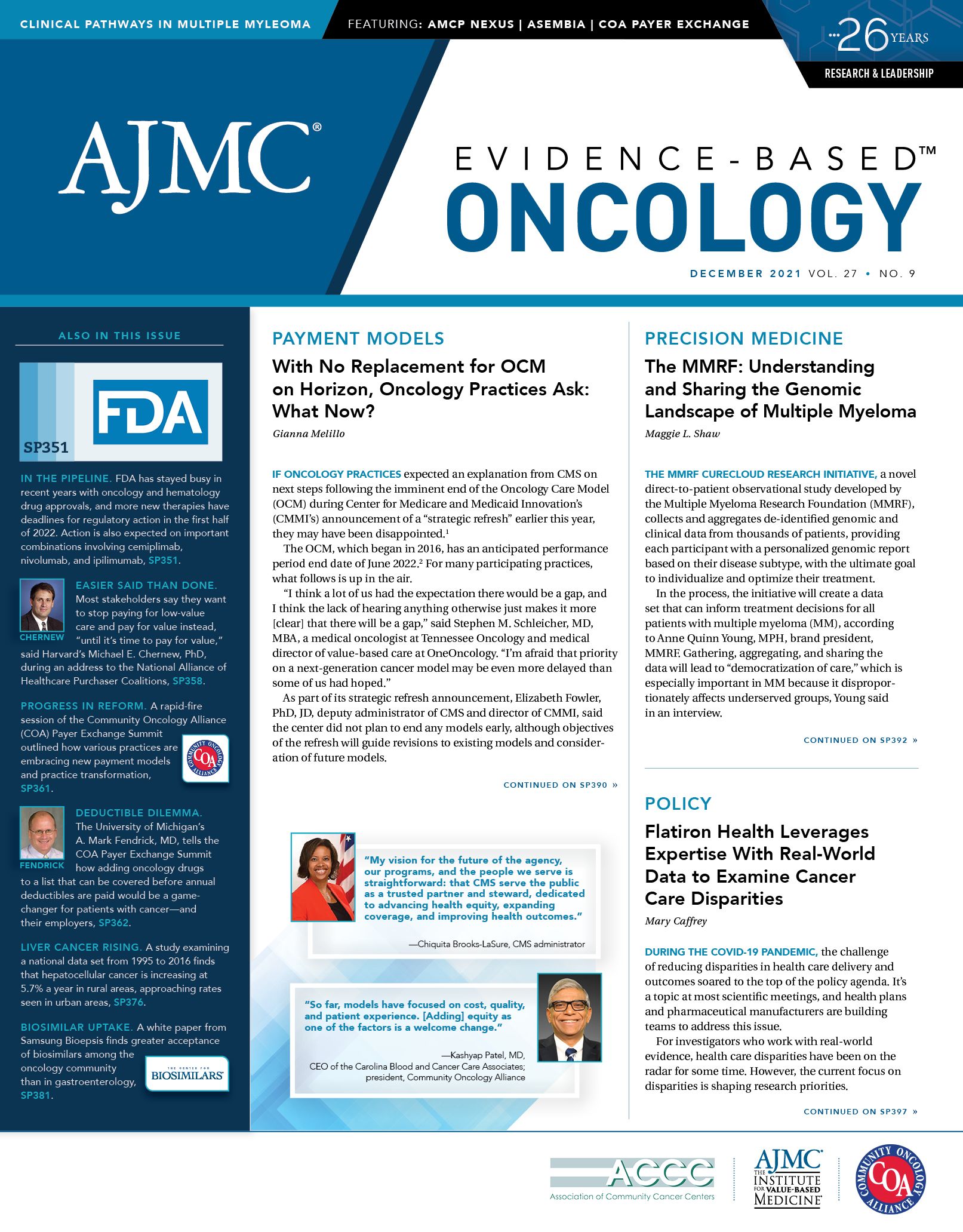Publication
Article
Evidence-Based Oncology
CONFERENCE COVERAGE: Asembia 2021
Author(s):
Coverage from the Asembia 2021 Specialty Pharmacy Summit in Las Vegas.
Simplifying the Complexity of Value-based Contracting: Present, Future Implications in Specialty Pharmacy
The current integration and future implications of value-based contracting (VBC) in specialty pharmacy signal a shift for payers, providers, and the pharmaceutical industry, and stakeholders must strategically position themselves to excel in a changing market, according to panelists in a session at the Asembia 2021 Specialty Pharmacy Summit in Las Vegas.
Noting that VBC will be an essential pillar in special pharmacy within the next 4 years, moderator Burt Zweigenhaft, PhD, DLitt, managing partner, Upstream Partners, opened the discussion by introducing the speakers on the panel and asking them how they would define VBC:
• Jeff Berkowitz, JD, chief executive officer, Real Endpoints
• Todd Grisco, vice president, Patient Value & Access, Takeda Oncology
• Kjel Johnson, PharmD, vice president, Specialty and Client Solutions, CVS Health
• Steven Peskin, MD, MBA, executive medical director, Population Health & Transformation, Horizon Blue Cross Blue Shield of New Jersey
• Michael Lynch, CPA, MBA, executive director, Oncology Market Access, Bayer
Although definitions of VBC vary across the health care system, Berkowitz explained that the essentials involve a performance-based reimbursement agreement between a payer and a pharma company that deals with pricing or reimbursement issues that are tied to the value of potential outcomes.
“You can have a lot of different ways of doing that, but the broadest is that you want to improve quality across the health care system with the drug that
you’re delivering, with the potential to lower overall costs,” he added.
Opening the scope of VBC to quality of care improvement in addition to cost, there remain several challenges that continue to impede the optimization of these agreements—specifically, internal alignment on market access and risk sharing, and transparency and trust when working with payers.
In mirroring Bayer’s VBC framework around clinical trials, which did not require contracts with payers and pharmacy benefi t managers, Lynch discussed how manufacturing these contracts warranted a top-down approach that was of value to manufacturers, patients, payers, and providers. Although the approach is seemingly complex, the simple effort of beginning these discussions was highlighted by Lynch.
“I think as you go into these, you’ll hit hurdles with one customer type or another customer type, but the idea is if you don’t start small and you don’t start early, then you won’t have that muscle memory. When it gets more
challenging, you won’t have that experience you’ll be able to rely on.”
From a pharmaceutical perspective, these agreements come with risk, but they also serve as an opportunity to get either preferred product placement or to diff erentiate one’s product from the competition.
Manufacturers can also address often burdensome prior authorizations with these products. In fact, Grisco noted that Takeda Oncology’s approach to VBC revolves around making their drugs more attractive as first-line therapies by reducing some of the uncertainty that payers and providers may have in utilizing their product.
Noting that their therapies for epidermal growth factor receptor–mutated non–small cell lung cancer are effective but not effi cacious for everyone due to toxicity, Takeda constructed a program focused on continuation of therapy to address those uncertainties of eff ectiveness and tolerability early in treatment. “For those patients who discontinued within the first 2
months, we’re providing a very signifi cant rebate back to our payer partners to reduce that uncertainty,” said Grisco.
Ultimately, engaging in these conversations with payers and providers is
warranted to optimize the full capabilities of VBC. “Across the board, whether it’s on the provider side, understanding it at the payer side, or the pharma side, we really have an evolution of skill sets that is needed to be able to have a much more coordinated, sophisticated conversation around delivering, and going at risk together, for a greater quality outcome at a potentially lower cost,” said Berkowitz.
In concluding, panelists provided several thoughts on the future of VBC and its growing importance in specialty pharmacy.
“Probably hundreds of VBCs are in eff ect today. So, they’re here, but they’re just not as eff ective as they need to be to be widely adopted,” said Grisco.
“The other thing is, we’re going to need fundamental changes in infrastructure to really enable VBCs to become core to a market access strategy, to a product’s commercialization strategy…. the whole world doesn’t have to go to VBCs, but there will be a subset of high-cost, potentially lower-utilization products that are really going to benefit, and that will take special changes.”
Berkowitz added that while he doesn’t expect structural changes when it comes to VBCs, the evolving capabilities of operating systems and potential transparency of derived data regarding the benefits of value-based care delivery could help drive these agreements further.






